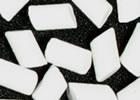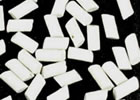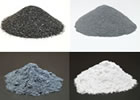Dalmatian Stone: aka "Dalmatian Jasper"

This image shows a 4-pound bag of dalmatian stone tumbling rough, dumped into a colander and sprayed with water to reveal its full color. Click on the image for a larger view.
Dalmatian Stone Tumbling and Cabbing Rough
 ,
,  , and
, and  What do they mean?
What do they mean?
Size: mostly 1/2 to 1 3/4 inch pieces
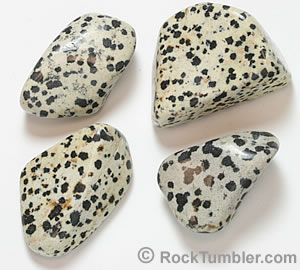
A few pieces of our Dalmatian Stone rough that we tumbled. It shapes nicely and polished to a soft glow. We were pleased with the results, and that is why we are now offering the rough to our customers.
The Dalmatian Stone that we are selling is mostly in 1/2" to 1 3/4" pieces. The four pound bags might have a few smaller pieces and a few larger pieces. That is expected when buying bulk rough. The background color of dalmatian stone can range from a light brown to a bright white. We like the material that we are selling because the density of the black spots is just right to deserve the "dalmatian" name. There are not too many and not too few.
When this material first hit the lapidary market almost everyone called it "Dalmatian Jasper." It looks like the breed of large white dog with black spots. The name was easy to remember and it stuck. It really stuck. Nobody had trouble remembering the name - even after hearing it only once. Some people will guess the name if you ask them to try. The problem -- this stuff isn't "jasper."

Here's an example of what Dalmatian Stone looks like when it has been tumble-polished in a rotary tumbler. The stones round nicely and the polish is more of a "soft glow" instead of the "bright glassy" polish that develops on pieces of agate and quartz.
What Is Dalmatian Stone?
Dalmatian stone is not a jasper. It is an igneous rock composed of white albite (a feldspar mineral) and black arfvedsonite (a mineral similar to hornblende). Arf! Some specimens might contain similar but closely related feldspar and amphibole minerals. Dalmatian stone shapes nicely in a rock tumbler in minimal time because it is softer than the agate, quartz and jasper that most people are used to tumbling. The minerals in dalmatian stone have a Mohs hardness of about 6, while quartz, agate and jasper have a hardness of 7.
If you want to know more about Dalmatian Stone, we have information about it and its lab analysis here.
INTERMEDIATE Rock Tumbling Recipe:
Dalmatian Stone (1/2 to 1 3/4 inches)
When tumbling this dalmatian stone two things should be considered:
1) Shapes Quickly: Dalmatian Stone is an igneous rock composed of white feldspar and a black hornblende group mineral (you can find more details here). These minerals have a Mohs hardness of about 5 to 6 so they will shape more quickly than the agate, jasper and petrified wood that most people tumble - and that have a Mohs hardness of about 7. For that reason, we suggest tumbling Dalmatian stone for less time during the coarse grit step of the tumbling process.
2) Media Needed: This Dalmatian Stone ranges in size between about 1/2" and 1 3/4". For that reason, ceramic media should be added to fill the voids between the large pieces of rough. These will provide a smoother tumbling action and deliver grit to the surfaces of the larger pieces of Dalmatian Stone. We would tumble a mixture of about 25% media and 75% Dalmatian Stone. Additional media should be added after the first tumbling step if the barrel volume drops below recommended levels.
Recipe for Rotary Tumbling
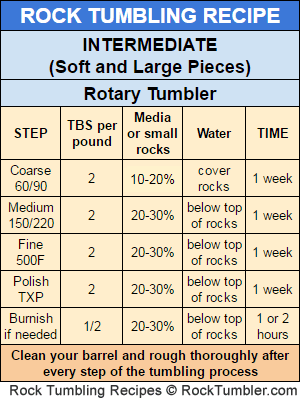
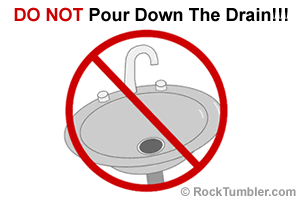
Barrel slurry dumped down the drain will harden like concrete.
Coarse Grit Step: Fill your barrel 2/3 full of rough and media (or small rough). About 10% to 20% of the material in the barrel should be ceramic media or small size rough. Then add 2 tablespoons of coarse (60/90) grit per pound of material in the barrel (rough + media). Add enough water to cover the rocks and tumble for one week.
Medium Grit Step: Put your cleaned rough and media back into the barrel. If the barrel is less than 2/3 full, add additional broken-in media to get the barrel up to its proper operating level. Then add 2 tablespoons of medium (150/220) grit per pound of material in the barrel. Finally, add enough water to put the water level just below the top of the rocks. Then tumble for 1 week.
Fine Grit Step: After clean-up, put the rocks and media back into the barrel with 2 tablespoons of fine grit per pound of material and enough water to bring the water level up to just a little below the top of the rocks. Tumble for one week. Your rocks should be really smooth after this step.
Polish Step: Make sure that your barrel and rough/media mix have been cleaned thoroughly of all grit and rock mud. Then place the rough and media in the barrel with two tablespoons of TXP polish for each pound of material in the barrel. Then add enough water to almost cover the rocks. Tumble for one week.
Burnish If Needed: If you have done a good job of tumbling, this tumbled magnesite will have a nice soft glow. It will not have the "glassy" polished luster that you can produce on agate. Burnishing will probably not be needed, but if you want to clean up the rocks, you can find the full burnishing instructions here.
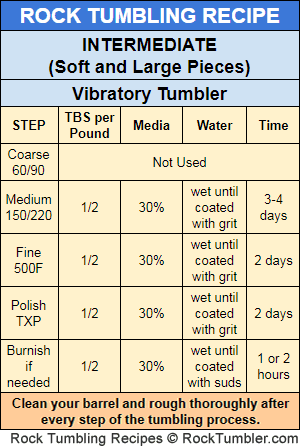
Vibratory Tumbler Recipe:
1/2" to 3" softer rough
Coarse Grit (60/90 Mesh):
Coarse grit is not used in a vibrating rock tumbler.
Medium Grit (150/220 Mesh):
Due to the size of this material it is recommended that you start with minimum of 30% ceramic media. The use of this media will aid in the tumbling action in the barrel and help deliver grit to all surfaces of the rough
After you have your bowl loaded to the manufacturer's recommended level add 1 tablespoon of grit for every two pounds of material, including the media, in the bowl. While the tumbler is running, slowly add water until the material has a thin coat of wet grit and the tumbling action is smooth and fast in the bowl.
Check the bowl every 8-12 hours to ensure the action is still good. If the action has slowed, add water a little at a time until the action is back to normal. If the mud gets too thick you will need to do a complete rinse of the material and bowl. After rinsing, add fresh grit and water and start tumbling again. You are done with medium grit when you are satisfied with the shape and smoothness of the stones. Usually 3-4 days for us with this material. Give the material and bowl a thorough cleaning before moving on to fine grit.
Fine Grit (500F Mesh):
Place your material back in the tumbler bowl, then add enough polished ceramic media to bring the load up to the manufacturer's recommended operating level. Add one tablespoon of grit for every two pounds of material in the bowl. Then, turn the tumbler on and slowly add water until the material has a thin coat of wet grit and the tumbling action is smooth and fast in the bowl.
Open the bowl every 8-12 hours to check the action is still good. We usually run fine grit for 48 hours. Thoroughly clean the bowl and material before moving to the polishing step.
Polish (#61 Rapid Polish or TXP):
Place the cleaned material back in the bowl. If needed, add ceramic media that has been previously polished, to bring the bowl up to the manufacturer's recommended operating level. Add one tablespoon of polish for every two pounds of material in the bowl. Turn on the tumbler and slowly add water. Stop adding water when the material has a thin coat of wet polish and the tumbling action is smooth and rapid.
Like the previous grit steps, open the bowl every 8-12 hours to check the tumbling action. Add water if it has slowed. We have found that 48 hours is usually all the time you need to get a good polish in a vibratory tumbler. Any more time than that and you run the risk of damaging / bruising the material.
Burnish If Needed:
This rough will usually take a great polish. However, burnishing this material after the polish step can often improve the look of the finished stones. If you would like to try burnishing to see if it improves the look of your polished stones, full burnishing instructions can be found here.
Customers also bought...
Large Ceramic Media

Small Ceramic Media

Standard Grit Kit



